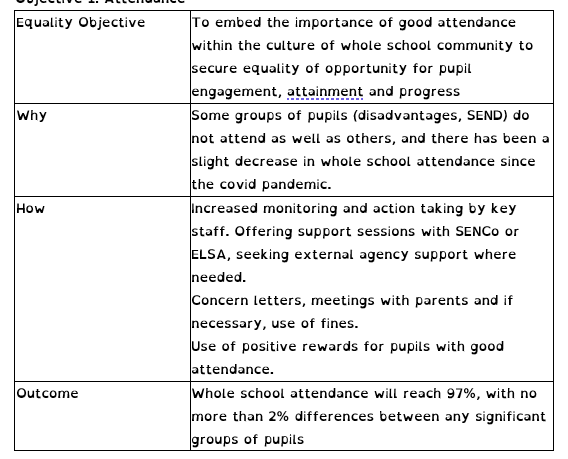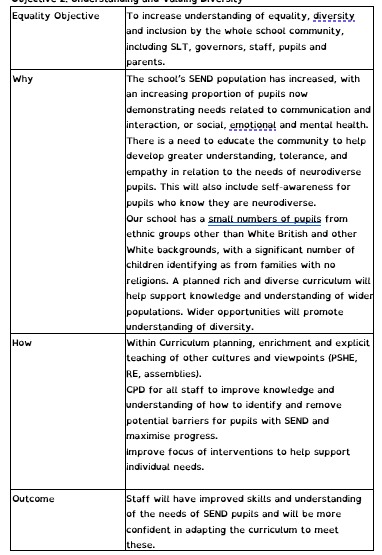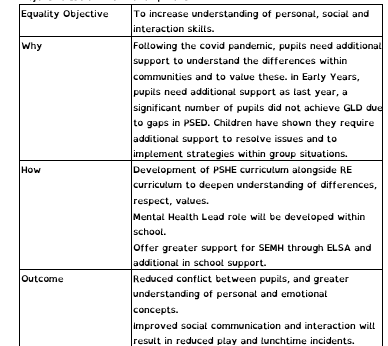Equality Statement
Our School Commitment
The Equality Act 2010 requires us to publish information that demonstrates that we have due regard for the need to:
- Eliminate Discrimination
- Provide Equality of Opportunity
- Foster Positive Relationships
Our Aim
At Berry Hill Primary School we aim to promote equality and develop positive relationships, by tackling any form of discrimination. We seek to remove any barriers that may prevent children from participating in all aspects of all life, making progress and achieving their full potential. We seek to remove barriers to access and participation that may prevent parents and carers being fully involved in the wider education of their child at school.
At Berry Hill Primary School our aim is to ‘bring out the best in everyone’ by:
- Ensuring that everyone is treated fairly and respectfully.
- Making our school a safe and secure place for everyone.
- Recognising that people have different needs, and we understand that treating people equally does not always involve treating them the same.
- Ensuring that no-one experiences less favourable treatment or discrimination because of:
- Age
- Disability
- Race
- Gender
- Gender identity
- Religion or belief
- Sexual identity and orientation
- Marriage or civil partnership
- Pregnancy/maternity
We aim to:
- Provide a safe environment where there is a strong focus on high expectations and challenge to improve outcomes for all our children.
- Provide a learning environment where all learners learn to be independent and resilient with the support of those around them.
- Prepare children for life in a culturally diverse society where the children are able to be confident in understanding their place and responsibilities in their local, regional, national and international communities.
- Include and value the contribution of all families to our understanding of equality and diversity with a clear focus on the participation of children and parents in decision-making.
- Provide positive non-stereotyping information about different groups of people regardless of protected characteristics under the law (age, disability, gender, gender identity, race, religion or belief, sexual orientation, marriage or civil partnership and pregnancy/maternity)
- Plan systematically to improve our children’s understanding and promotion of diversity
- Actively challenge all types of discrimination.
- Ensure that positive messages and actions about inclusion, equality and diversity are part of our daily practice.
To achieve these aims we will:
- Work closely with other agencies to actively promote inclusion, equality and diversity.
- Involve stakeholders in the development, review, evaluation, and impact assessment of relevant improvement plans, policies and procedures.
- Publish and share our policies and impact assessments with the whole community.
- Collect and analyse data to ensure all groups are progressing well and no group is disadvantaged.
- Use all available information to set suitable learning challenges, respond to children’s individual needs and support children in overcoming potential barriers to their success.
- Ensure that the broader school curriculum promotes and celebrates inclusion, equality and diversity.
- Maintain high expectations of behaviour which demonstrate respect to others.
- Ensure that all reasonable adjustments are made to ensure equality of opportunity with respect to disability or varying needs.
- Apply a graduated approach to identifying and supporting pupils and students with SEND.
- Have a co-ordinated assessment process towards an Education, Health and Care plan (EHC plan) for those children identified as having significant and complex needs, where families are fully involved in planning, commissioning and reviewing services.
- Actively promote parent/carer engagement to monitor that needs are met and provision is appropriate.
Equality Objectives
In order to meet our school’s general and specific duties under the Equality Act 2021, the following information has been prepared.
Understanding our school community - Pupils
There are 452 children on roll. There are 213 Girls and 246 boys.
What information on pupils is collected by protected characteristics?
The information in March 2023:
81% of our pupils are White British, with 19% of pupils representing a range of different ethnic backgrounds, with the second most prominent group being any other white background (6.4%)
Pupils with SEND form 11.4% of our school population.
8.3% of our pupils are classified as disadvantaged.
49% of our school population identify as having no family religion. 32% identify as having Christian family ethos. 3.5% identify as having Muslim beliefs.
No information is available for the following protected characteristics which are not recorded within school:
Gender reassignment – the school did not have any information on whether any of the children on roll had reassigned their gender.
Sexual identify – the school did not have any information on whether any of the pupils on roll identified as LGBTQ+
Understanding the information gathered:
Using whole school monitoring, information gathered, the school looked at the following to identify if there were any obvious gaps or potential issues for pupils in relation to the protected characteristics.
- Admissions
- Attainment
- Attendance
- Engagement in social activities
- Exclusions
- Prejudice related incidents
- Rewards and sanctions
- Representation on school bodies eg football team, school council.
Following our analysis, we have developed our Equality Objectives to meet the following requirements of the Equality Act:
- Eliminate Unlawful Discrimination, harassment, victimisation and any other conduct prohibited by the Act
- Advance Equality of Opportunity, between persons who share a relevant protected characteristic and persons who do not share it
- Foster Good Relations between persons who share a relevant protected characteristic and persons who do not share it
Objective 1: Attendance

Objective 2: Understanding and Valuing Diversity

Objective 3: Personal Development

